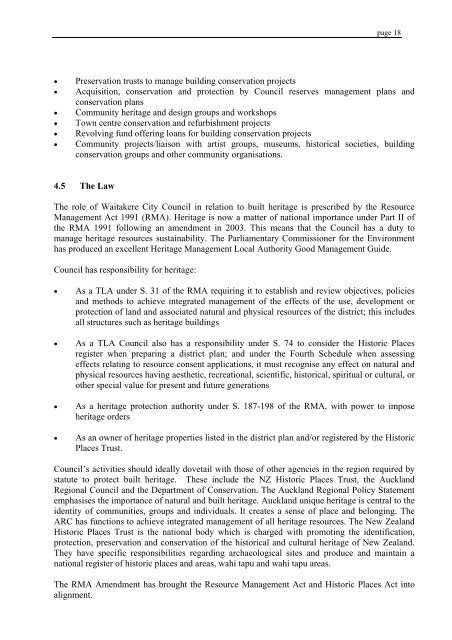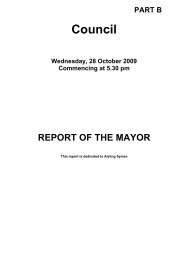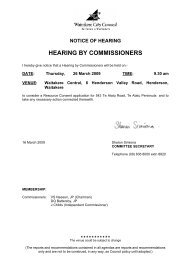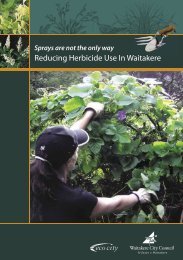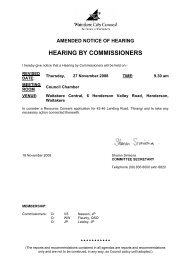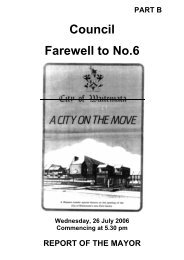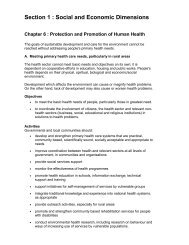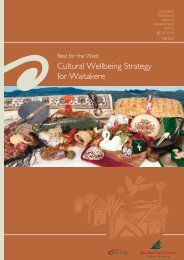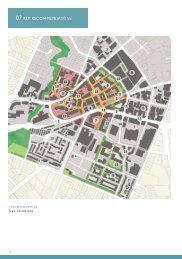Heritage Strategy Action Plan - Auckland Council
Heritage Strategy Action Plan - Auckland Council
Heritage Strategy Action Plan - Auckland Council
You also want an ePaper? Increase the reach of your titles
YUMPU automatically turns print PDFs into web optimized ePapers that Google loves.
page 18<br />
• Preservation trusts to manage building conservation projects<br />
• Acquisition, conservation and protection by <strong>Council</strong> reserves management plans and<br />
conservation plans<br />
• Community heritage and design groups and workshops<br />
• Town centre conservation and refurbishment projects<br />
• Revolving fund offering loans for building conservation projects<br />
• Community projects/liaison with artist groups, museums, historical societies, building<br />
conservation groups and other community organisations.<br />
4.5 The Law<br />
The role of Waitakere City <strong>Council</strong> in relation to built heritage is prescribed by the Resource<br />
Management Act 1991 (RMA). <strong>Heritage</strong> is now a matter of national importance under Part II of<br />
the RMA 1991 following an amendment in 2003. This means that the <strong>Council</strong> has a duty to<br />
manage heritage resources sustainability. The Parliamentary Commissioner for the Environment<br />
has produced an excellent <strong>Heritage</strong> Management Local Authority Good Management Guide.<br />
<strong>Council</strong> has responsibility for heritage:<br />
• As a TLA under S. 31 of the RMA requiring it to establish and review objectives, policies<br />
and methods to achieve integrated management of the effects of the use, development or<br />
protection of land and associated natural and physical resources of the district; this includes<br />
all structures such as heritage buildings<br />
• As a TLA <strong>Council</strong> also has a responsibility under S. 74 to consider the Historic Places<br />
register when preparing a district plan; and under the Fourth Schedule when assessing<br />
effects relating to resource consent applications, it must recognise any effect on natural and<br />
physical resources having aesthetic, recreational, scientific, historical, spiritual or cultural, or<br />
other special value for present and future generations<br />
• As a heritage protection authority under S. 187-198 of the RMA, with power to impose<br />
heritage orders<br />
• As an owner of heritage properties listed in the district plan and/or registered by the Historic<br />
Places Trust.<br />
<strong>Council</strong>’s activities should ideally dovetail with those of other agencies in the region required by<br />
statute to protect built heritage. These include the NZ Historic Places Trust, the <strong>Auckland</strong><br />
Regional <strong>Council</strong> and the Department of Conservation. The <strong>Auckland</strong> Regional Policy Statement<br />
emphasises the importance of natural and built heritage. <strong>Auckland</strong> unique heritage is central to the<br />
identity of communities, groups and individuals. It creates a sense of place and belonging. The<br />
ARC has functions to achieve integrated management of all heritage resources. The New Zealand<br />
Historic Places Trust is the national body which is charged with promoting the identification,<br />
protection, preservation and conservation of the historical and cultural heritage of New Zealand.<br />
They have specific responsibilities regarding archaeological sites and produce and maintain a<br />
national register of historic places and areas, wahi tapu and wahi tapu areas.<br />
The RMA Amendment has brought the Resource Management Act and Historic Places Act into<br />
alignment.


